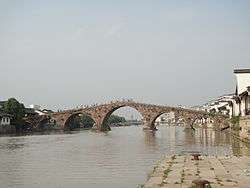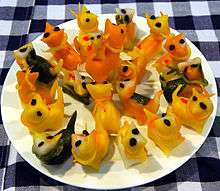Tangxi, Hangzhou
Tangxi[1], or often referred to as Tangqi, is a county-level town located on the north side of Hangzhou in China's Zhejiang, 10 kilometers away from the main city of Hangzhou.[2] Tangqi was established 1,000 years ago,[3] and it is famous for its unique fruit called Loquat, also the Prunus mume in the neighborhood area of Chaoshan Mountain.
Tangxi 塘栖 | |
|---|---|
County Town | |
塘栖镇 | |
 | |
| Coordinates: 30°47′N 120°18′E | |
| Country | People's Republic of China |
| Province | Zhejiang |
| Sub-provincial city | Hangzhou |
| Population | |
| • Total | 90 000 |
| Time zone | UTC+8 (China Standard) |
| Postal code | 311106 |
| Area code(s) | 0571 |
| Website | www |
History
Tangqi Town has a long history of more than 1,000 years, first built in the Northern Song dynasty (960–1127).[2] It used to be a small fishing village. During the Yuan dynasty, Zhang Shicheng broadened the Grand Canal, and then the local fishermen gradually settled down on both sides, first settling the town. In the Ming dynasty, the Tongji Bridge (通济桥) connected both sides, and the town was enlarged. The local record of history named Tangqi Zhi has the specific details. During the Ming and Qing dynasties, ancient Tangqi town ranked the first of top ten famous towns in the Jiangnan region. Originally, Tangqi town was under the administration of Renhe County. During the Republican era, Hang County was established, and Tangqi was removed to Hang County. Before 1949, the ancient Tangqi town consisted of north town and south towns, but the south town belonged to Hang County and north town belonged to Deqing County. In May, 1950, Tangqi ended the separation. Currently, Tangqi is the second largest town of Yuhang District.[2]
Historical sites
Guangji Bridge

Guangji Bridge was built in 1494. At 78.7 meters long, 5.2 meters wide, and 13.86 meters high, it was the only 7-arch stone bridge on the Grand Canal. It is rumoured that the Guangji Bridge was built in the Tang dynasty and expanded in the Ming dynasty. There are 80 steps on each side of the bridge.[4]
Qianlong Stele
The Qianlong Stele was originally located in the branch of Hangzhou Water Conservancy Office in the early Republican era. The office site was destroyed but the stele was reserved because it was embedded into the wall of house of Lu Jinjiang, who was the first executive officer of Chongyu silk production factory.
The height of the Qianlong Stele is 5.45 meters. The header part is 1 meter high, 1.5 meters wide with the relief of "Two dragons playing a pearl" on it. The main body part is 3.35 meters high, 1.4 meters wide and 0.5 meters thick. The uncovering bottom part is 1.1 meters high 1.8 meters wide, and 0.8 meters thick. The stele was engraved with 429 Chinese characters as the main text and 10 Chinese characters as the signature of the Qianlong Emperor. The written characters served as the regular script. The Stele is decorated by carvings of cloerds and dragons.[5]
The main content of the stele describes that the Qianlong Emperor rewarded Zhejiang to pay enough amount of grains as taxes even during the period of the natural disaster when he inspected southern China in 1751. The emperor specially permitted Zhejiang province to reduce the land tax and poll tax by 30 million taels of silver and built the stele to inform the people.
The Qianlong Stele was recognized as a cultural relic under Hangzhou in 2004. The stele and the site of the branch of Hangzhou Water Conservancy Office were then recognized as a cultural relic of Zhejiang province in 2011.[6]
Plum-Blossoms in Chaoshan Mountain
Chaoshan Mountain is one of the top three places to view plum-blossoms in Jiangnan. The scene of plum-blossoms here is world-renowned for its distinguishing features, that is, "old, wide and rare". It has a reputation of "a fragrant sea of plum-blossoms" in history.[2][7]
- Old—China has five sorts of ancient plum-blossoms named the Jin, Sui, Tong, Song, and Yuan breeds, and Chaoshan Mountain is boasts of two; the Tang and Song plum tree.[2]
Tang Plum Tree: Tang Plum Tree is located in front of fragrance Pavilion. It said that Tang Plum Tree was the incarnation of fairy named Jiangmei. It was very graceful and particular sculpting indeed. With the history of more than one thousand years, it has experienced years of wind and frost, but it blooms every year, with enchanting blossoms.[8]
Song Plum Tree: Among Chaoshan plum trees, the one most worth mentioning is the Song Plum tree, which is located in front of the hall of Great Brightnees. The body of the original plum tree has already withered to a large extent, looking like a half a piece of bark with nothing in its trunk and moss on the surface. The trunk is bent like an old dying man. However, it still sprouted out and bloomed out of six petal flowers in spring. It was quite thought-provoking to see the new blossoms and the old trunk. However, it died in the end.[8]
- Wide—Chaoshan Mountain at its golden days had a sea of plum-blossoms which extended for miles. It was a "fragrant sea" for good reason. Nowadays, there are still hundreds and thousands of plum-blossom trees, with a variety of more than ten categories such as scarlet, pink, red and green breeds,[2] and it is reputed as "Plum fragrance can be felt within 10 miles" and " Chaoshan plum blossoms are second to none" .[8]
- Rare—It is rather rare that the plum-blossoms here in Chaoshan Mountain have six petals, while those in other places usually have five petals.
As plum-blossoms bloom every year in early spring, there are spectacular scenes of petals dancing in the air as snow flakes. Wu Changshuo, the neoteric master of inscription, Chinese painting and calligraphy, as well as the first president of Xiling Seal Society, was very fond of plum-blossoms in Chaoshan Mountain.[2]
Traditional cuisine
- Ci mao ruo yuan(刺 毛 肉 圆)
Ci mao ruo yuan is concerded one of the most famous foods for the Tangqi Town. It consists of meatball and glutinous rice. It was said the Ci mao ruo yuan was invented by a local chief at a time when the Qianlong Emperor once travelled down south from Beijing via the Grand Canal.[9]
- Xi Sha Yang Wei(细沙羊尾)
Unlike Ci mao ruo yuan, Xi Sha Yang Wei is a dish of dessert. It is a fried dough with large amount of red bean paste inside it. It is named after its shape, which is very much like the tail of a sheep.[10]
Tradition
- Lixia Dog (立夏狗)
It is believed that eating a dog shape made of 80% glutinous rice and 20% of rice vermicelli during Lixia could protect children from chronic summer fever.[11]

Notable residents
Wu Changshuo
Born in Anji, Zhejiang Province, Wu Changshuo (1844–1927) was a central figure in Chinese painting during the early years of the 20th century.[12] Wu influenced a later trend in painting that belonged to a Chinese artistic movement known as the Shanghai School. This highly influential cultural trend became dominant in painting as well as in cinema, music and literature. The Shanghai School had a romantic character and stressed the idea of "art for art's sake", it combined eastern and western aesthetics and reflected the great changes that cities such as Shanghai were going through. Wu started painting rather late during his thirties and he was fully able to express his diverse skills and talent.[13] After his death, he was interred under the Chaoshan.[14]
Feng Zikai
One of the most famous Chinese artists in the 20th century, Feng Zikai enjoyed the sign and Loquat of Tangqi.[15]
References
- "余杭区地名办提供最权威说法应该念成塘xī 尊重当地大部分人的读音·都市快报" [Yuhang District Geographical Naming Office provides the most authoritative saying that it should be pronounced as tangxī, respecting the pronunciation of most local people]. Hangzhou Daily (in Chinese). February 7, 2012. Retrieved June 24, 2020.
- "Tangqi Ancient Town". Tangqi GOV. Archived from the original on 12 July 2007. Retrieved 19 May 2013.
- "Tangqi town to opens to tourists as of National Day". chinabaike.com. Retrieved 14 May 2013.
- "广济桥". tangqi.org.cn. Archived from the original on 2 May 2014. Retrieved 14 May 2013.
- "The Grand Canal Hangzhou". en.grandcanal.com.cn. Retrieved 14 May 2013.
- "运河瑰宝——塘栖干隆御碑". 林金木. Retrieved 14 May 2013.
- "Palm blossom at Chaoshan". en.wl-expo.com. Archived from the original on 19 April 2014. Retrieved 14 May 2013.
- "The Chaoshan Scenic Area". cstour.cn. Archived from the original on 24 December 2013. Retrieved 14 May 2013.
- "刺 毛 肉 圆". Tangqi Gvo. Retrieved 14 May 2013.
- "细沙羊尾". Tangqi Gvo. Retrieved 14 May 2013.
- "Tradition of Tangqi – Lixia Dog". 三点一四一屋酒. 2007-05-17.
- "Wu Changshuo". Encyclopædia Britannica. Retrieved 14 May 2013.
- "Wu Changshuo". arts.cultural-china.com. Archived from the original on 2012-05-25. Retrieved 14 May 2013.
- "吴昌硕简介". wuchangshuo.artron.net. Retrieved 14 May 2013.
- "[名人剪影]悠闲诗意 丰子恺在塘栖". 新华网浙江频道. 2009-05-30. Archived from the original on 2 May 2014. Retrieved 14 May 2013.